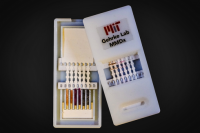-
Vertical-take-off-and-landing personal aircraft to beat rush-hour traffic
A German start-up company is developing the world’s first vertical takeoff and landing aircraft for personal use. The electric two-seater will open the door to a new class of simpler, quieter, and environmentally friendly planes available from 2018. The plane is classed as a Light Sport Aircraft for two occupants, with the pilot’s license requiring twenty hours’ minimum training – almost like taking a driving license.
-
-
Marine Corps, Sandia collaborate on microgrids and renewable energy planning
The U.S. Marine Corps are the first boots on the ground in a crisis. On the front lines, they must be able to power up securely without plugging into utilities. They require nothing less than completely reliable and cost-effective energy independence. Researchers from Sandia National Laboratories are collaborating with the Marine Corps to increase their energy security and reduce fuel dependence through alternative technologies, including renewable energy and microgrids.
-
-
Cellphone-sized device detects the Ebola virus quickly

The worst of the recent Ebola epidemic is over, but the threat of future outbreaks lingers. Monitoring the virus requires laboratories with trained personnel, which limits how rapidly tests can be done. Now scientists report in ACS’ journal Analytical Chemistry a handheld instrument that detects Ebola quickly and could be used in remote locations.
-
-
DHS, NASA collaborate in search of innovation in homeland security

Crowdsourcing and incentive prizes across industry have led to the successful creation of advanced technologies, such as autonomous vehicles and improved data analytics. The DHS Science and Technology Directorate (S&T) is expanding its efforts to solicit innovations like these through its partnership with NASA.
-
-
Coded apertures improves, shrinks mass spectrometers for field use

A modern twist on an old technology could soon help detect rogue methane leaks, hidden explosives, and much more. Mass spectrometers were invented in the 1930s, and they are still typically the size of an oven or refrigerator. Inherent hurdles to miniaturization have made it difficult to use them outside of a laboratory. Researchers are using software to dramatically improve the performance of chemical-sniffing mass spectrometers. With the help of modern data analytics, researchers have demonstrated a technology using a so-called “coded aperture” that promises to shrink these devices while maintaining their performance.
-
-
New way to clean contaminated groundwater

A team of researchers has helped discover a new chemical method to immobilize uranium in contaminated groundwater, which could lead to more precise and successful water remediation efforts at former nuclear sites. Uranium is present in contaminated groundwater at various sites in the United States as a legacy of Cold War-era processing and waste disposal activities associated with nuclear materials production.
-
-
Non-state actors exploiting emerging technologies, complex engineering
In a special issue of the Journal of Strategic Security, experts explore the threat of violent non-state actors (VNSAs) exploiting emerging technologies and executing complex engineering operations to facilitate their violent and criminal activities. The special issue of the journal presents the results of a series of case studies of VNSAs and their attempts to increase their capabilities through engaging in sophisticated engineering efforts.
-
-
Laser cloaking device to help us hide Earth from aliens
Several prominent scientists, including Stephen Hawking, have cautioned against humanity broadcasting our presence to intelligent life on other planets. Two astronomers suggest humanity could use lasers to conceal the Earth from searches by advanced extraterrestrial civilizations.
-
-
Flexible security solution makes life difficult for burglars
Ideally, homeowners want to be warned if a burglar sneaks onto their property, and farmers want to know if horses or sheep are no longer in the paddock or field they were left grazing in. Experimental physicists at Saarland University have developed a flexible security solution that can be used in gardens, driveways, business premises, or on grazing land and in woodland.
-
-
DARPA’s seeking innovative system-level technologies
DARPA’s Tactical Technology Office (TTO) focuses on developing and demonstrating innovative system-level technologies and prototypes that incorporate new and emerging technologies, for the purpose of preserving and extending U.S. military advantages over potential adversaries. To help accomplish these goals and inform potential performers about TTO’s technical objectives, TTO has scheduled its fourth annual Proposers Day for Wednesday and Thursday, 20 and 21 April 2016.
-
-
Mathematics helps search and rescue ships sail more safely in heavy seas

Fast ships deliver all kinds of services in fields such as disaster response, the fight against crime, the provision of supplies for oil and gas platforms, and the transportation of wind farm maintenance personnel. Each year, however, around 100 such ships worldwide are lost or damaged in heavy seas, with around 2,500 casualties in 2013. A unique new computer model built on highly complex mathematics could make it possible to design safer versions of the “fast ships” widely used in search-and-rescue, anti-drugs, anti-piracy, and many other vital offshore operations.
-
-
Identifying national security threats posed by everyday commercial technologies

For decades, U.S. national security was ensured in large part by a simple advantage: a near-monopoly on access to the most advanced technologies. Increasingly, however, off-the-shelf equipment developed for the transportation, construction, agricultural, and other commercial sectors features highly sophisticated components, which resourceful adversaries can modify or combine to create novel and unanticipated security threats. DARPA’s “Improv” effort asks the innovation community to identify commercial products and processes that could yield unanticipated threats.
-
-
Microwave repairs might annihilate zombie potholes once and for all

Some potholes are like zombies – they never die. Or at least that’s the perception of much of the driving public, especially as we enter peak pothole season: late winter and early spring. Recurring “zombie” potholes are too often a reflection of the type of method that’s used to patch or “fix” them – many of which are short-lived and only marginally effective. Researchers around the world are working to develop better and longer lasting repair alternatives. Microwave technology is not yet a routine method of repair, and it’s best-suited for potholes in asphalt rather than concrete. But this approach merits further consideration. After all, given our nation’s aging network of roads, zombie potholes will continue to flourish. Microwave repair could be an effective method for keeping them at bay.
-
-
New laser-based aircraft tracking system to aid in disaster relief efforts
A ground-breaking tracking system called HYPERION, based on eye-safe lasers, could enable aircraft, unmanned aerial vehicles (UAVs), and even orbiting satellites to transmit vital data to ground stations more securely, quickly and efficiently. HYPERION, offering major benefits compared with the traditional radio frequency (RF) data transmission systems currently relied on in the UAV sector, could allow UAVs engaged in disaster monitoring, surveying, search and rescue, and other humanitarian missions to send detailed images more rapidly back to the ground for analysis.
-
-
Miniaturized fuel cell makes drones fly more than one hour
Drones are used for various applications such as aero picturing, disaster recovery, and delivering. Despite attracting attention as a new growth area, the biggest problem of drones is its small battery capacity and limited flight time of less than an hour. A newly developed fuel cell can solve this problem.
-
More headlines
The long view
New Technology is Keeping the Skies Safe
DHS S&T Baggage, Cargo, and People Screening (BCP) Program develops state-of-the-art screening solutions to help secure airspace, communities, and borders
Factories First: Winning the Drone War Before It Starts
Wars are won by factories before they are won on the battlefield,Martin C. Feldmann writes, noting that the United States lacks the manufacturing depth for the coming drone age. Rectifying this situation “will take far more than procurement tweaks,” Feldmann writes. “It demands a national-level, wartime-scale industrial mobilization.”
How Artificial General Intelligence Could Affect the Rise and Fall of Nations
Visions for potential AGI futures: A new report from RAND aims to stimulate thinking among policymakers about possible impacts of the development of artificial general intelligence (AGI) on geopolitics and the world order.
Keeping the Lights on with Nuclear Waste: Radiochemistry Transforms Nuclear Waste into Strategic Materials
How UNLV radiochemistry is pioneering the future of energy in the Southwest by salvaging strategic materials from nuclear dumps –and making it safe.
Model Predicts Long-Term Effects of Nuclear Waste on Underground Disposal Systems
The simulations matched results from an underground lab experiment in Switzerland, suggesting modeling could be used to validate the safety of nuclear disposal sites.
